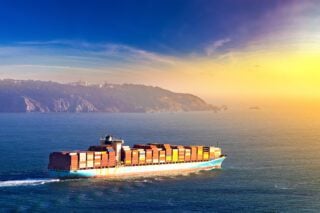
A new report sheds light on the use of asbestos in commercial ships, uncovering a global problem. Despite regulations limiting or banning its use, asbestos still finds a way on board sea vessels. Its continued use may put sailors and their families at risk of developing mesothelioma.
The report details how some ships get certified “asbestos free” while still having it on board. The problem stems from uneven adoption, interpretation and enforcement of global regulations.
International Treaty Sets Standards but Lacks Teeth
The average lifespan of a cargo ship is 25 to 30 years. After the ship has become obsolete, it may be dismantled. If the ship has asbestos, taking it apart can endanger the people tasked with the work.
The use of asbestos has a long history in sea-going vessels. It has even been used in ships belonging to the United States Navy. For commercial ships, a treaty called the International Convention for Safety of Life at Sea (SOLAS) protects commercial sailors. It sets safety standards for the construction and operation of ships, and more than 160 countries have signed the treaty.
Over the years, SOLAS has received updates to address new concerns. A 2002 update focused on asbestos. The update allowed ships built before July 1, 2002 to have asbestos as long as it is handled correctly. For ships built between 2002 and 2011, the update allowed the use of asbestos in some applications. The 2011 update to SOLAS completely prohibited asbestos use in newly built ships.
However, recent industry surveillance shows these measures have not eliminated asbestos. CTI-Maritec is a consulting group that reports ship-related environmental concerns. CTI-Maritec’s findings show a surprising number of ships still have asbestos:
- Nearly 55% of ships currently in service
- Roughly 50% of newly built ships
CTI-Maritec found some certified “asbestos-free” ships still harbor the dangerous mineral. How can this happen? Several factors allow countries to say “asbestos free” without truly meaning it.
Inconsistent Asbestos Regulations Create Loopholes for Shipbuilders
Every country has its own set of laws surrounding the use of asbestos. Some countries limit how much asbestos can be used in new components, and others allow asbestos use without restriction. Even SOLAS countries may not interpret or enforce SOLAS guidelines consistently. These loopholes create opportunities for ships to contain asbestos with or without carrying the label of “asbestos free.”
Some Countries Have Banned Asbestos and Others Have Not
Experts linked asbestos to serious diseases as far back as 1918, but some countries still use it. In fact, only 67 countries have banned asbestos use, and the United States is not one of them.
Countries without a total ban may have limits on the amount of asbestos that can be used in new construction. Some, such as India, have no restrictions on its use. These varying levels of restriction can affect asbestos use in ships in unpredictable ways. This may make it difficult for sailors to identify and respond appropriately to asbestos materials on ships.
SOLAS Enforcement Varies Country-to-Country
Another issue is that acceptable levels of asbestos vary from country to country. While SOLAS has guidelines, enforcement standards are not clear. And, SOLAS does not train certificate issuers. Shipbuilders and registers may decide on their own interpretations of SOLAS guidelines with little to no oversight.
So, if a ship meets the asbestos standards in their registry, it can get certified. But, that certification may not meet another country’s standards. Thus, countries that have looser restrictions can say their ship is free from asbestos even if it has asbestos-containing components.
Repairs Can Happen Anywhere
Commercial ships travel a lot, and through those travels, pieces may wear out and break down. In some cases, repairs happen in foreign ports. If that country has looser restrictions on asbestos, the ship may take on parts that use asbestos.
A ship may be asbestos free after construction, but it may pick up replacement parts in ports where asbestos is still in use. Many ships make minor repairs while in service, potentially exposing sailors to harm from asbestos.
Protecting Sailors From Mesothelioma
Research shows that sailors have an elevated risk of mesothelioma. This may be due to the fact that sailors live and work on the asbestos-containing ships for extended times. Even working on “asbestos-free” ships may still expose sailors to asbestos.
One way to protect sailors from this risk is an international ban on asbestos. Developing a unified front through advocacy would be the first step.
Until every country bans its use and requires older ships to remove it, sailors and their family members will continue to suffer from the effects of asbestos. People who develop mesothelioma symptoms after serving on an older ship should contact a mesothelioma doctor. Patients should be careful to disclose any asbestos exposure to their physicians. This can help determine the true cause of the patient’s symptoms.




